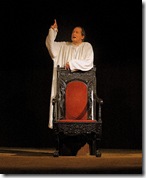 And I am back to my blog. Not that I had disowned Agilecat, but just that I have a little more time these days compared to the last three years, as I gear up to transition into a new product at a new organization.
And I am back to my blog. Not that I had disowned Agilecat, but just that I have a little more time these days compared to the last three years, as I gear up to transition into a new product at a new organization.This comeback blog is dedicated to all product managers who have renovated themselves to become ‘product owners’. I realize that there has been a lot of deliberation and analysis on this topic, but in today’s post, I am going to touch upon just that one aspect which is crucial to both the roles - ‘physical presence’.
Yes, you got to be there. At the right time with the right people! A nice PM stays in constant contact with his ‘customers’, and to be a nice PO, he must and always be present with the scrum team. This is one large aspect of variation between the descriptions of duties between these two titles.
The Product Manager, by definition, is the voice of market. He is coached to stay out, experience the souk, observe the users, study the customers and so on. The agile Product Owner role characterization lays a lot of emphasis on conducting planning meetings, giving first hand feedback to scrum teams, participating in review sessions and so on. So from a distance, this looks pretty clear – PM stays out of the office, while PO sits alongside the team. Two roles, pretty distinct, right?
If you look closely, these roles may appear to have dissimilar portrayals, but share a common goal - that of connecting the dots between the market and the team. Yes, it is fundamental for a good PO to understand his customers and market, and equally imperative for the PM to identify with his team dynamics. If there is one person playing both these roles, he’s got to master that sweet balance of staying home with the team, and also out their in the field!
Time management and self prioritization become crucial for such an agile PM/PO person. His typical calendar week best describes the role he plays, and nothing else.
Agile methods encourage frequent release iterations, and call for stake holders, sponsors etc. to be significantly involved in product development. This helps in reducing risks, and at the same time makes it easy for the PM/PO to engage users and sponsors by making sure that his product stays in touch with them, while he stays in touch with the product.
Exploiting social media tools to engage, listen and gauge the market sentiments is not new anymore, and is more and more becoming mainstream in product management techniques. While it clearly does not obviate that need for physical presence, it surely helps the PM/PO to better prioritize his ‘facetime’.
Some argue that being a product manager and an agile PO at the same time results in overburdening of one person, and that is true, mostly because with that oath of “product owning” comes a never ending endeavor to help build great agile teams, along with winning products. Another way to look at this is to treat the agile team as another ‘product’ in the making, and PO playing chief architect on that project.
 All this while, doing market research, if you have been hunting answers for the "what-the-customer-wants" question, I can give you the answer. Here it comes. The envelope please...
All this while, doing market research, if you have been hunting answers for the "what-the-customer-wants" question, I can give you the answer. Here it comes. The envelope please... Most of a Product Manager's business life is spent in avoiding problems. However, in market research he has to eagerly seek out problems. Problems are very strong motivators of consumer purchases, and customer buy-in's. People will buy something they believe will solve a problem that afflicts them.
Most of a Product Manager's business life is spent in avoiding problems. However, in market research he has to eagerly seek out problems. Problems are very strong motivators of consumer purchases, and customer buy-in's. People will buy something they believe will solve a problem that afflicts them.

 Believe me, killing your own product is the most painful task you can ever be "told" to do. Sometimes, we are in so much love with what we build, that we tend to forget the ecosystem around it. This could be a BLUNDER for any product manager.
Believe me, killing your own product is the most painful task you can ever be "told" to do. Sometimes, we are in so much love with what we build, that we tend to forget the ecosystem around it. This could be a BLUNDER for any product manager.